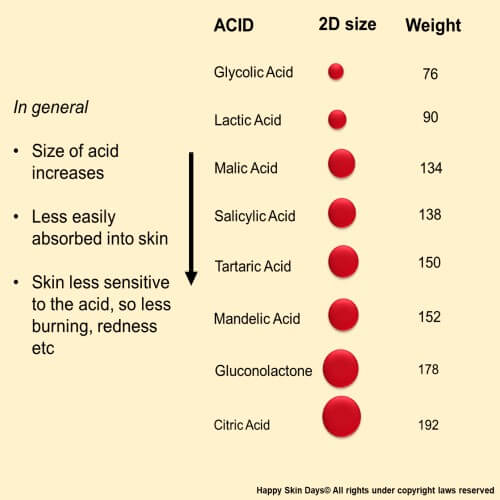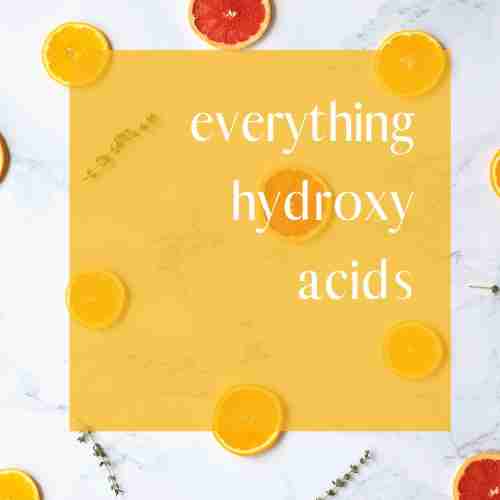(All references supporting the acid series are available at this LINK)
Some of the feedback I have received on my previous blogs is that readers just want to know about acids and not their relation to chemical peels.
As the genie in the lamp, I exist to serve and this is what today’s blog is about. Apologise if its repetitive for some of you 🙂
1.Introduction
I was inspired to write this blog series because I couldn’t answer this question:
Based on my skin’s characteristics, which hydroxy acid should I use?
My skin’s characteristics are: Indian, wheatish to dark complexion, tan very easily, have hyper-pigmentation, my scars leave a dark mark that fades over time and I am not 25 years old.
I couldn’t answer this question based on other numerous and infinitely wiser blogs, vlogs out there. I can’t go to a dermatologist (quarantine life, stay at home)…so I set out to answer this question.
2. Which Acid am I referring to?
Glycolic Acid, Salicylic Acid, Lactic Acid, Mandelic Acid and Gluconolactone.
Only the first three acids are really relevant b/c they are the most prevalent in skincare products. This is based on the Ingredient labels of 74 products from the Sephora USA website (see this Which acids are important?)

Other acids that you will see on Ingredient labels and on the internet are: Tartaric Acid, Citric Acid, Pyurvic Acid, Malic Acid and so on. Honestly, I don’t know why anyone would even give these acids any attention because they are present in so few subjects. I will write a separate blog, but we can ignore them.
Also, before someone (metaphorically) throws a cucumber at me, Citric Acid is mainly used as a chelating agent in skincare…
3. What acids am I NOT deliberately talking about?
I have written extensively about Vitamin C on my blog. Kojic Acid and Azelaic Acid can have similar outcomes to (e.g.) salicylic acid, but as an Asian, I primarily associate them as skin lighteners. Similarly (e.g.), many skin barrier repair creams contain Niacinamide, but in my experience this is the no 1 ingredient used by Indian skincare brands to facilitate skin lightening.
4. How are acids classified and where do they come from?
All the acids I am writing about are hydroxy acids: AHA, BHA and PHA. Most acids that you find in your products are made in lab, but they also occur naturally.
| Name of the acid | Classification | Compound similar to? | Natural source |
| Glycolic Acid | AHA | Sugar cane juice | |
| Lactic Acid | AHA | Sour milk, tomato juice | |
| Salicylic Acid | BHA, but is also an aromatic carboxylic acid (see below) | Aspirin | Wintergreen leaves, Willow, Sweet Birch Bark |
| Mandelic Acid | AHA (but phenyl group is attached to α carbon) | Some anti-biotics | Bitter Almonds |
Which are fat and water soluble?
Only Salicylic Acid on this list is lipid soluble. If someone has (e.g.) acne, then this means that the Salicylic Acid can not only penetrate the skin, but also the sebum and the intent with (e.g.) a Salicylic Acid cleanser is that the Salicylic Acid removes the excessive amounts of sebum.
The AHA – Glycolic Acid, Lactic Acid are water soluble and cannot act on sebum in this manner. If you have acne, you’ll know that the preferred treatment options include Salicylic Acid And not GA or LA.
Does size and weight matter?
It kind of does. Glycolic Acid is the smallest AHA and because it is so small it penetrates into your skin very quickly. Contrast this to Mandelic Acid which is approximately twice as heavy, and it unsurprisingly takes longer to be absorbed by the skin.

This also explains why first-time users of Glycolic Acid are more likely to experience some of the AHA side-effects: redness, swelling, burning, Post Inflammatory Hyperpigmentation. Such complaints don’t ordinarily feature for Mandelic Acid.
5.What other factors influence the performance (benefits and side-effects) of acids?
The product’s effects depend on:
- pH of the product
- Percentage concentration of the AHA:
- in low concentrations (4% -10%) the are promoted as effective for ameliorating skin aging.
- in high concentrations (>20%) they are used in chemical peels…
- How is the AHA being delivered? Cream? Peel?
- Frequency of use
- Where on the skin it is applied.
Even though you can (technically) buy Glycolic Acid at 30% in some countries, this is the Cosmetic Ingredient Review’s (American self-regulatory body) recommendation:
- AHA’s concentration <10%
- Final products have a pH of 3.5 or greater
- Final packaging indicates increased sun sensitivity and directs users to wear sunscreen (we’ll come back to this)
6. Benefits
One of the most cited beneficial effects of HAs is the improvement of photoaged skin. These improvements come in the form of reduced skin roughness, reduced discoloration, pigmentation and an increase in the density of collagen
If all goes to plan, then these are the generic benefits of hydroxy acids:
As the hydroxy acids have an exfoliating action, these will:
- Promote cellular turnover, exposing new younger looking, brighter and more glowing skin. (This skin has simply not been exposed to the elements)
- Improve the effectiveness of topical skin treatments, which after the top layer of the skin is removed are able to penetrate the skin deeper.
Regular use of hydroxy should:
- Increase collagen production in the skin, resulting in a thicker epidermis and visually, younger looking skin
- Decrease the thickness of Stratum Corneum
- Diminishes fine lines and wrinkles
- Reduces hyperpigmentation (via more even distribution of melanin)**
** See side-effects below
For each acid, I’ll expand benefits in individual blogs.
7. Side-effects
The side effects will depend on the factors identified above (pH, % concentration, mechanism of delivery and frequency of use) and in my view, these 2 additional factors:
- Skin type – whether skin is Fitzpatrick type I, II, III, IV or IV
- Behaviourial – once you see a great result (e.g.) with Glycolic Acid 30%, do you either then use it every day or do you move to a higher concentration (e.g.) Glycolic Acid 40% and use that very frequently.
Once you see a great result, you are likely to overuse the product, without understanding that over-use may make the product more like a chemical peel. (see this blog for the relationship between acids and chemical peels)
Therefore, the side effects of using acids that I have listed are the same when the product is used as a chemical peel.
In general, these are common side-effects (but as with benefits, these are not the only side-effects):
- Severe redness (erythema)
- Swelling
- Burning
- Skin discolouration
- Blistering
- Rash and Bleeding
- Post Inflammatory Hyper-pigmentation*
* PIH arises in Fitpatrick type IV, V and VI because of, “unpredictable response of melanocytes to injury that can cause disfiguring post-inflammatory change.”
In plain English, chemical peels can cause increased or severely reduced melanin production after the peel in a way that cannot be predicted. You can end up with more or less pigmentation then before the treatment….
